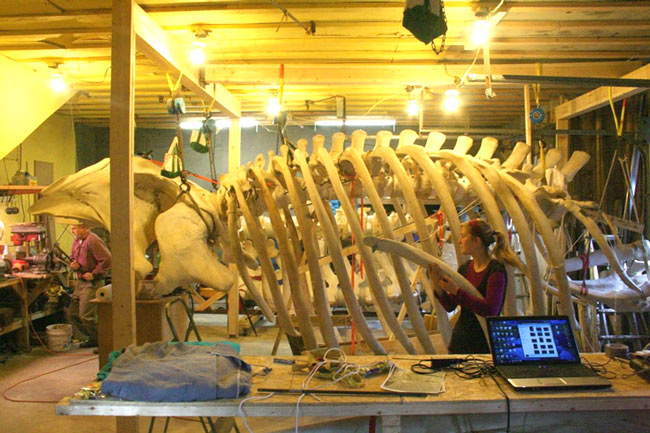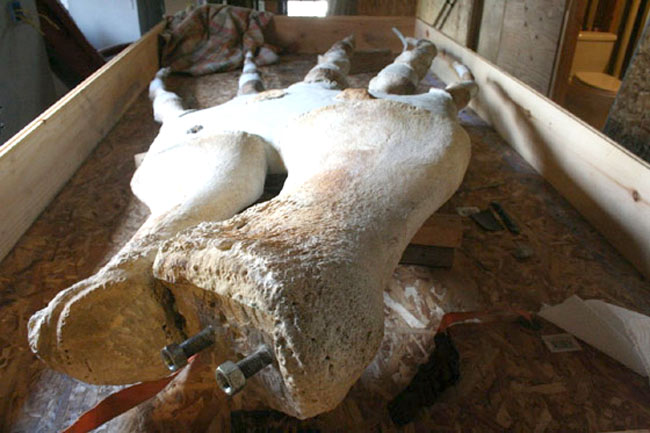Right Whale Mother and Fetus
Skeletons Reconstructed
by Laurie Schreiber

Stumpy, a right whale matriarch who died in 2004, fills the shop of DenDanto’s Whales and Nails, as Toby Stephenson, left, and Lindsey Nielsen fit ribs on the upper third of the reassembled spine. Laurie Schreiber Photo
Stumpy lived a long and fruitful life, but she and the nearly full-term fetus inside of her met with a tragic end.
Stumpy was a North Atlantic right whale who received the name because she was missing part of her right fluke, almost certainly due to a ship strike that she survived earlier in her life. In 1981, she was entered into a photo-identification catalogue kept by the New England Aquarium Right Whale Catalogue.
Stumpy was pregnant with a late-term male fetus when she was struck and killed by a large ship in 2004. Her carcass and that of her baby were collected on Feb. 11, 2004 at Nags Head, N.C., after first having been observed dead at sea off of Rudee Inlet of Virginia Beach, Va.
Recently, the skeletons of Stumpy and her fetus went on display at the North Carolina Museum of Natural Science's new Nature Resource Center, in Raleigh, N.C.
The final cleaning, preservation and articulation of the skeletons was done by whale experts Dan DenDanto and Toby Stephenson, and DenDanto’s assistants.
DenDanto is a biologist and whale researcher who lives in Seal Cove and runs his business, Whales and Nails, out of his home. The “nails” part is about carpentry. Affiliated with Allied Whale – College of the Atlantic’s marine mammal research group – he also specializes in the re-articulation of large marine mammal skeletons. Since 1993, DenDanto has cleaned and re-articulated about a dozen skeletons for professional commissions. A year ago, he was finishing up the re-assembly of a 21-foot-long killer whale and a 24-foot northern bottlenose whale – both collected in the first half of the 19th century off the Faroe Islands in the Norwegian Sea – for an exhibit at Harvard University.
Stephenson is a marine biologist and educator, the captain of the College of the Atlantic’s research vessel and director of Bar Harbor Whale Museum.
The mother right whale’s skeleton measured 52 feet long; the 17 _-foot-long fetal skeleton was placed inside the area that would have been her uterus.
“This is not just any North Atlantic right whale. This is the mother of them all,” said DenDanto. “She is the mother of a whole bunch of North Atlantic right whales.”
In 2004, he said, Stumpy was one of two right whales killed off North Carolina by ship strike that year; both carried fetuses.
DenDanto said this will be the second whale articulation he’s done that places a fetal skeleton inside the mother.
“When you look at it, there will be no mistaking that she was a pregnant mom,” he said.
DenDanto, who began work on Stumpy last June, said she was one of two specimens that was the subject of studies to understand the forces that were involved in bone fractures from ship strikes. Because of the data yielded by her death, he said, the animal became key to the drafting of new regulations to slow down vessel traffic around large port cities. He said that marine mammal researchers cross-sectioned her jaw bone, from which they took core samples to determine bone density and the force required to break it.
“What they determined was that, if you could slow vessels down below 10 knots, the collision would often be survivable. But above that threshold, they were almost always fatal,” he said. “I think it’s fascinating, because it’s where science influences policy and, in this case, policy won. So what you have here is the most critically endangered large whale, certainly our most endangered animal in the United States in terms of a mammal species, and this one is a notable character because it was well known by researchers for 20-plus years, and it’s at the apex of all this research that was fundamental to our current understanding of collisions and what helps to lessen the negative impact of ship collisions.”
DenDanto said the skeletons of mother and fetus ended up in the collection of the North Carolina museum, which contacted him three years ago about reassembling the bones for an exhibit.
“We were honored to be asked,” he said. “This is three-year discussion in the making. It takes a long time to bring these things to fruition.”
The age of the mother is unknown, but it is certain that she is old, and she could be at least 60 to 80 years old or more, he said.
The focus of the North Carolina exhibit, he said, is not the story of this particular pair, but to show how right whales are studied.
“These are important individuals to preserve,” he said. “It’s the breeding females that are the most important. And a very high percentage of ship-killed animals are females.”
The assembly of the skeletons involved factors such as the calibration between the bones and decisions regarding the materials to be used to support and fasten the bones.

Seen here is one of the flippers of the right whale recently reconstructed by Dan DenDanto and his crew. Laurie Schreiber Photo
“It’s analogous to stringing beads,” he said of the vertebrae. “There’s a certain spacing that we’re aware of. Between each vertebra, we simulated cartilage between the bones of the spine. We have control over that spacing. It’s wider toward the tail section where the animals have more movement.”
“I cannot impress how marvelous the size of the fetus was,” he said. “I did a fetus for a right whale before, and it was only 12 feet. This one measures some 17 feet. The question is, how to fit it into her at that size….We’re really in unknown territory. We talked a lot with leading scientists in the field about what would be the fetal posture at this point in its gestation. Would it be folded over and bent on itself? Would it be in a linear configuration? What we do know with certainty is that all whales are born tail first. They’re unlike the rest of the mammals; they actually kick their way out of their moms.”
As voluntary breathers, he said, whale babies coming out of the womb must stay attached to the umbilical cord until they are entirely birthed, so that they can get up to the water’s surface for their first breath of air.
“And we know with certainty, with the toothed whales, that they’re bent right over into a question mark shape until right near the end,” he continued. “But it’s at least thought that, with right whales, they might straighten out in the third – what would be analogous to a trimester – that they get into a linear posture. People don’t know.”
The mother probably weighed 60,000 to 80,000 pounds when she died, he said. After her death, she floated at sea with the baby inside of her until she washed up on shore.
“Literally, the fetus just pulverized inside of her for the day or two she floated around,” he said. “They described the fetus as being like a sock that contained loose bones.”
DenDanto said the project has involved twin goals of creating an elegant and accurate design while also telling a story that educates the public. On the ground, ancillary displays will include information about right whale research and details such as an inflatable boat manned by a model of a dog that is trained to sniff out right whale scat, reportedly a new technique used by researchers to find the animals on the high seas.
“What’s fascinating too about right whales is not just that they’re so rare, but that they’re so intensively researched,” he said.
He said the museum anticipates that a million viewers per year will see the exhibit.
“From the museum science perspective, there’s what should be, and there’s the story of what you’re trying to explain,” he said. “For me, and I think I can speak for Toby, that is something that we’re passionate about. How do you get it right and not have all the wires and all the steel struts, so that it’s simple and elegant, and it conveys something to people who see it – keeping in mind that your viewer range in a museum is huge? You have everyone from PhD academics to little children. And you have to do something that speaks to all of them. There are welding and construction sciences here, and then there’s whale anatomy, which is traditional science. And then there’s art and sculpture, too. And I think it’s all of that. This is my 12th or 13th large-whale professional articulation, and still, every one is different. Every one is a learning experience. And every time I’m asked to do one of these things, I just feel very fortunate.”
